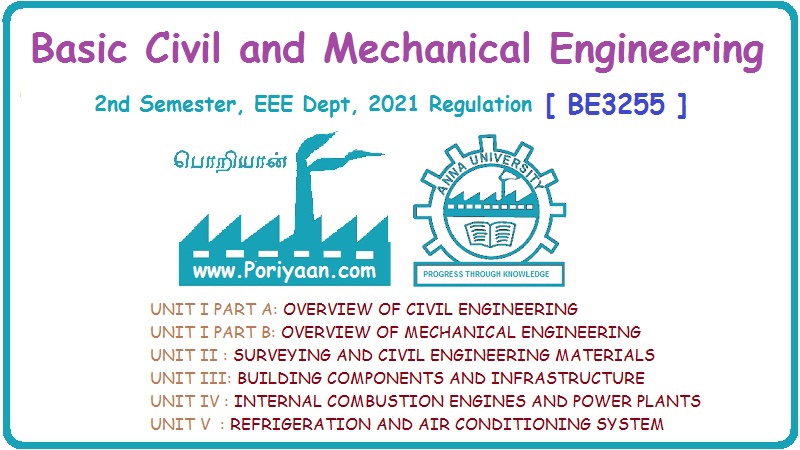Basic Civil & Mechanical Engineering: UNIT I: n. Energy engineering
Principle of conservation of energy
Energy engineering
In physical and chemical processes, a change in mass is very difficult to determine since it is too small.
PRINCIPLE OF CONSERVATION OF ENERGY
In
physical and chemical processes, a change in mass is very difficult to
determine since it is too small. It is assumed that the mass and energy of the
substances involved in a process are constant. This assumption is emphasized by
the Law of Conservation of Energy.
One
of the most fundamental laws of Nature is the Conservation of Energy Principle.
It simply states that during an interaction, energy can change from one form to
another, but the total amount of energy always remains constant. That is,
energy cannot be created or destroyed.
Examples
(i)
Water is flowing from an overhead tank through a pipe. Potential energy is
converted into kinetic energy.
(ii)
A rock falling off a hill picks up speed, as its potential energy is converted
to kinetic energy.
(iii) The conservation of energy principle
also forms the backbone of the diet industry: A person, who has a greater
energy input (food) than energy output (exercise), will gain weight (store
energy in the form of fat). A person who has a smaller energy input than output
will lose weight.
(iv)
You are applying brake to your two-wheeler. In this process, kinetic energy of
the wheel is converted into heat due to friction.
1. FIRST LAW OF THERMODYNAMICS
First
Law of Thermodynamics is an expression of Law of Conservation of Energy. It
states that energy is a thermodynamic property. According to this Law, the
total energy of an isolated system in all its forms remains constant.
Consider
a system where there is energy transfer. The net amount of energy transferred
in various forms should be equal to the change in internal energy of the
system, with the possibility of conversion of one form of energy into any other
form.
2. SECOND LAW OF THERMODYNAMICS
If
the First Law of Thermodynamics states that all forms of energy are convertible
to one another, the Second Law puts a limitation on the conversion of some
forms of energy to others
Second
Law of Thermodynamic states that “It is impossible for heat energy to flow from
a body at a lower temperature to a body at a higher temperature without the aid
of external work.”
Example:
A cup of hot coffee left on a table eventually cools. The high temperature
energy of o the coffee is degraded (i.e., transformed into a less useful form
at a lower temperature), once it is transformed to the surrounding air. But, a
cup of cool coffee in the same room never gets hot by itself.
The
second law indicates that heat cannot be entirely converted into work. The
portion of heat that cannot be converted into work is called Unavailable
Energy, which is rejected as low grade heat after the work is done.
Reversible
and Irreversible Processes in a Thermal System
Entropy
Entropy is defined with respect to a reversible process. A Reversible Process
is one that after being executed on a system can be reversed. The same system
can be brought back to its initial state without any change to the surrounding.
Example: Condensation or boiling of liquids.
Any
process, which is not reversible, is called an Irreversible Process. All
natural processes are irreversible types. The important sources of
irreversibility in nature are: friction, heat transfer, throttling and mixing.
Examples:
(i)
Friction created by a rotating shaft in a bearing generates heat. Is it
possible to rotate the shaft by supplying the same amount of heat? No. The heat
transfer from a high temperature source to a low temperature source cannot reverse
itself without external work.
(ii)
Process of combustion.
(iii)
Free unrestricted expansion of gases.
We
must have some measure of quality of energy as well as a measure of the
irreversibility of a process. A property used to measure the quality of energy
or irreversibility of the process is known as Entropy,
Basic Civil & Mechanical Engineering: UNIT I: n. Energy engineering : Tag: : Energy engineering - Principle of conservation of energy
Related Topics
Related Subjects
Basic Civil and Mechanical Engineering
BE3255 2nd Semester 2021 Regulation | 2nd Semester EEE Dept 2021 Regulation
